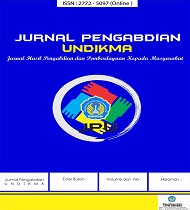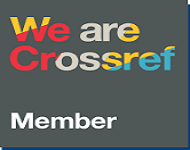Analysis of Guided Inquiry-Based Cladistic E-Worksheet Development to Improve Critical Thinking in High School
DOI:
https://doi.org/10.33394/jk.v8i3.5359Keywords:
Guided Inquiry Learning, Cladistic E-worksheet, Classification of Living Things, Critical Thinking.Abstract
References
Aini, Z., Ramdani, A., & Raksun, A. (2018). Perbedaan Penguasaan Konsep Biologi Dan Kemampuan Berpikir Kritis Siswa Kelas X Pada Penerapan Model Pembelajaran Kooperatif Tipe Group Investigation Dan Guided Inquiry Di Man 1 Praya. Jurnal Pijar Mipa, 13(1), 19. https://doi.org/10.29303/jpm.v13i1.466
Anam, K. (2016). pembelajaran Berbasis Inkuiri: Metode dan Aplikasi. Pustaka Pelajar.
Anderson, L. W., & Krathwohl, D. . (2001). A Taxonomy for Learning, Teaching and Asessing: A Revision of Bloom’s Taxonomy of Educational Objectives (A Bridged). Addison Wesley Longman, Inc.
Anugrahana, A. (2020). Hambatan, Solusi dan Harapan: Pembelajaran Daring Selama Masa Pandemi Covid-19 Oleh Guru Sekolah Dasar. Scholaria: Jurnal Pendidikan Dan Kebudayaan, 10(3), 282–289. https://doi.org/10.24246/j.js.2020.v10.i3.p282-289
Ardi, A., Nyeneng, D. P., & Ertikanto, C. (2015). Pengembangan Modul Pembelajaran Fisika Berbasis Inkuiri Terbimbing Pada Materi Suhu Dan Perubahannya. Jurnal Pembelajaran Fisika Universitas Lampung, 3(3), 117355.
Asrial, H., & Ernawati, M. D. W. (2020). E-worksheet for science processing skills using kvisoft flipbook. International Journal of Online and Biomedical Engineering, 16(3), 46–58. https://doi.org/10.3991/IJOE.V16I03.12381
Choo, S. S. Y., Rotgans, J. I., Yew, E. H. J., & Schmidt, H. G. (2011). Effect of worksheet scaffolds on student learning in problem-based learning. Advances in Health Sciences Education, 16(4), 517–528. https://doi.org/10.1007/s10459-011-9288-1
Eddy, S. L., Crowe, A. J., Wenderoth, M. P., & Freeman, S. (2013). How should we teach tree-thinking? An experimental test of two hypotheses. Evolution: Education and Outreach, 6(1), 1–11. https://doi.org/10.1186/1936-6434-6-13
Ennis, R. H. (1993). Critical thinking assessment. Theory Into Practice, 32(3), 179–186. https://doi.org/10.1080/00405849309543594
Ennis, R. H. (2018). Critical thinking across the curriculum. 37(1), 165–184.
Facione, P. a. (2015). Critical Thinking : What It Is and Why It Counts. In Insight assessment (Issue ISBN 13: 978-1-891557-07-1.). https://www.insightassessment.com/CT-Resources/Teaching-For-and-About-Critical-Thinking/Critical-Thinking-What-It-Is-and-Why-It-Counts/Critical-Thinking-What-It-Is-and-Why-It-Counts-PDF
Fauzy, A., & Nurfauziah, P. (2021). Kesulitan Pembelajaran Daring Matematika Pada Masa Pandemi COVID-19 di SMP Muslimin Cililin. Jurnal Cendekia : Jurnal Pendidikan Matematika, 5(1), 551–561. https://doi.org/10.31004/cendekia.v5i1.514
Fitriani, F., Samad, A., & Khaeruddin, K. (2014). Penerapan Teknik Pemberian Reinforcement (Penguatan) Untuk Meningkatkan Hasil Belajar Fisika Pada Peserta Didik Kelas VIII.A SMP PGRI Bajeng Kabupaten Gowa. Jurnal Pendidikan Fisika Unismuh, 2(3), 120887.
Ganefri, Hidayat, H., Kusumaningrum, I., & Mardin, A. (2017). Needs analysis of entrepreneurships pedagogy of technology and vocational education with production base learning approach in higher education. International Journal on Advanced Science, Engineering and Information Technology, 7(5), 1701–1707. https://doi.org/10.18517/ijaseit.7.5.1510
Hikmawati, H., Suastra, I. W., & Pujani, N. M. (2020). Ethnoscience-Based Science Learning Model to Develop Critical Thinking Ability and Local Cultural Concern for Junior High School Students in Lombok. Jurnal Penelitian Pendidikan IPA, 7(1), 60. https://doi.org/10.29303/jppipa.v7i1.530
Julaeha S. (2019). Analisis kemampuan tree thinking siswa SMA melalui penerapan OIDDE learning terintegrasi formative assessment berbasis web. Sekolah Pascasarjana UPI.
Kaltakci, D., & Oktay, O. (2011). A guided-inquiry laboratory experiment to reveal students’ comprehension of friction concept: A qualitative study. Balkan Phys. Letters, 19(January 2011), 180–190. http://bpl.turkfizikdernegi.org/vol19/19-1-020.pdf%5Cnpapers3://publication/uuid/A36AA635-6BB3-4A39-85F3-637509F2BC41
Kemendikbud. (2013). Permendikbud Nomor 65 Tahun 2013 Tentang Standar Proses. 2011, 1–13.
Kemendikbud. (2015). Implementasi Kurikulum 2013. Jurnal Inovasi Pendidikan, 1(3).
Matuk, C., & Uttal, D. H. (2020). The Effects of Invention and Recontextualization on Representing and Reasoning with Trees of Life. Research in Science Education, 50(5), 1991–2033. https://doi.org/10.1007/s11165-018-9761-4
Munandar, H., & Sutrio, M. T. (2018). Pengaruh Model Pembelajaran Berbasis Masalah Berbantuan Media Animasi Terhadap Kemampuan Berpikir Kritis Dan Hasil Belajar Fisika Siswa Sman 5 Mataram Tahun Ajaran 2016/2017. Jurnal Pendidikan Fisika Dan Teknologi, 4(2).
Murni, R. L. F., Harlita, & Widoretno, S. (2017). The Implementation of Guided Inquiry Learning to Improve Students’Interpretation Data Skill in Class XI IPA 4 Academic Year 2016/2017 with materials of human excretory system. Proceeding Biology Education Conference, 14(1), 355–360. https://jurnal.uns.ac.id/prosbi/article/view/18812
Novak, J. D., & Gowin, D. B. (1984). Learning How To Learn. ISSN 2502-3632 (Online) ISSN 2356-0304 (Paper) Jurnal Online Internasional & Nasional Vol. 7 No.1, Januari – Juni 2019 Universitas 17 Agustus 1945 Jakarta, 53(9), 1689–1699.
Oktari, S., Maharta, N., & Ertikanto, C. (2015). Pengembangan LKS Berbasis Inkuiri Terbimbing pada Materi Suhu dan Kalor. Jurnal Pembelajaran Fisika Unila, 3, 48–57.
Partnership for 21st Century. (2015). Learning and Innovation Skills-4Cs Key Subjects-3Rs and 21st Century Themes Critical thinking • Communication Collaboration • Creativity P21 Framework for 21st Century Learning 21st Century Student Outcomes and Support Systems Framework for 21st Century L. www.P21.org.
Permana P, N. D., & Manurung, I. F. U. (2020). Penggunaan Bahan Ajar Digital Berbasis Inquiry pada Masa Pandemi Covid-19 untuk Mata Kuliah Pembelajaran IPA di SD Kelas Tinggi. El-Ibtidaiy:Journal of Primary Education, 3(2), 73. https://doi.org/10.24014/ejpe.v3i2.11008
Pratiwi, P., Supriatno, B., & Anggraeni, S. (2021). Alternatif Desain Kegiatan Laboratorium Materi Kladogram Berbasis ANCORB. BIODIK: Jurnal Ilmiah Pendidikan Biologi, 7(2), 71–84.
Rands, V., Hood, S., Gerrits, R., & Jensen, M. (2021). Implementing Guided Inquiry Active Learning in an Online Synchronous Classroom and its Impact on Test Question Performance. Journal of the Human Anatomy and Physiology Society, 25(2), 6–12. https://doi.org/10.21692/haps.2021.015
Rositawati, D. N. (2019). Kajian Berpikir Kritis Pada Metode Inkuiri. Prosiding SNFA (Seminar Nasional Fisika Dan Aplikasinya), 3, 74. https://doi.org/10.20961/prosidingsnfa.v3i0.28514
Rustaman, N. (2005). Perkembangan Penelitian Pembelajaran Inkuiri Dalam Pendidikan Sains Development of Research in Inquiry Science Teaching. Seminar Nasional II, 22–23.
Rustaman, N. (2011). Empowering Thinking Process to Develop Learners’ Ability to Recognize Biodiversity through Classification and Their Reasoning. Makalah Ilmiah disajikan dalam Seminar Taksonomi Di Eka Karya Bedugul.
Rustaman, N. (2015). Integrasi Aspek Afektif-Kognitif melalui Pembelajaran Bioresources Berorientasi Local Wisdom dan Berpikir Sistem untuk Membekali Perilaku Konservasi .Prosiding Biotik, 1–11.
Rustaman, N. (2019). Pemberdayaan Klasifikasi-Generalisasi dan Tree Thinking Untuk Membangun Disposisi Berpikir Generasi Muda Dalam Mengelola Bioresources di Indonesia. Pemanfaatan Biodiversitas Dalam Mewujudkan Biobased Ecogreen.
Southworth, J. (2022). Bridging critical thinking and transformative learning: The role of perspective-taking. Theory and Research in Education, 20(1), 44–63. https://doi.org/10.1177/14778785221090853
Sukma, Komariyah, L., & Syam, M. (2015). Pengaruh Model Pembelajaran Inkuiri Terbimbing ( Guided Inquiry ) Dan Motivasi Terhadap Hasil Belajar Fisika Siswa Program Studi Pendidikan Fisika Fakultas Keguruan dan Ilmu Pendidikan pembelajaran yang berpusat pada siswa . Namun kenyataannya kegiatan be. Saintifika; Jurusan PMIPA, FKIP, Universitas Jember, 18(1), 49–63. http://jurnal.unej.ac.id/index.php/STF
Susilawati, E., Agustinasari, A., Samsudin, A., & Siahaan, P. (2020). Analisis Tingkat Keterampilan Berpikir Kritis Siswa SMA. Jurnal Pendidikan Fisika Dan Teknologi, 6(1), 11. https://doi.org/10.29303/jpft.v6i1.1453
Taherdoost, H. (2018). Validity and Reliability of the Research Instrument; How to Test the Validation of a Questionnaire/Survey in a Research. SSRN Electronic Journal, January 2016. https://doi.org/10.2139/ssrn.3205040
Wale, B. D., & Bishaw, K. S. (2020). Effects of using inquiry-based learning on EFL students’ critical thinking skills. Asian-Pacific Journal of Second and Foreign Language Education, 5(1). https://doi.org/10.1186/s40862-020-00090-2
Wijaya, E. Y., Sudjimat, D. A., & Nyoto, A. (2016). Transformasi Pendidikan Abad 21 Sebagai Tuntutan. Jurnal Pendidikan, 1, 263–278.
Yustina, Syafii, W., & Vebrianto, R. (2020). The effects of blended learning and project-based learning on pre-service biology teachers’ creative thinking skills through online learning in the COVID-19 pandemic. Jurnal Pendidikan IPA Indonesia, 9(3), 408–420. https://doi.org/10.15294/jpii.v9i3.24706
Downloads
Published
How to Cite
Issue
Section
Citation Check
License
License and Publishing Agreement
In submitting the manuscript to the journal, the authors certify that:
- They are authorized by their co-authors to enter into these arrangements.
- The work described has not been formally published before, except in the form of an abstract or as part of a published lecture, review, thesis, or overlay journal.
- That it is not under consideration for publication elsewhere,
- That its publication has been approved by all the author(s) and by the responsible authorities tacitly or explicitly of the institutes where the work has been carried out.
- They secure the right to reproduce any material that has already been published or copyrighted elsewhere.
- They agree to the following license and publishing agreement.
Copyright
Authors who publish with JK agree to the following terms:
- Authors retain copyright and grant the journal right of first publication with the work simultaneously licensed under a Creative Commons Attribution License (CC BY-SA 4.0) that allows others to share the work with an acknowledgment of the work's authorship and initial publication in this journal.
- Authors are able to enter into separate, additional contractual arrangements for the non-exclusive distribution of the journal's published version of the work (e.g., post it to an institutional repository or publish it in a book), with an acknowledgment of its initial publication in this journal.
- Authors are permitted and encouraged to post their work online (e.g., in institutional repositories or on their website) prior to and during the submission process, as it can lead to productive exchanges, as well as earlier and greater citation of published work.
Licensing for Data Publication
-
Open Data Commons Attribution License, http://www.opendatacommons.org/licenses/by/1.0/ (default)

This work is licensed under a Creative Commons Attribution-ShareAlike 4.0 International License.







